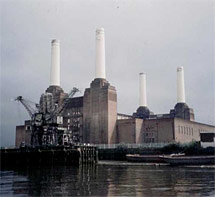
The icon of London, Battersea Power Station, is at risk
 |
Throughout the years, there have been no shortage of ideas for what to do with the complex located on the southern bank of the Thames, immortalized on the cover of Pink Floyd's album Animals. Proposals have included a shopping center, a museum, a housing and office complex, or an amusement park. However, projects have fallen one after another due to financial obstacles.
Since the end of 2011, Battersea Power Station has been for sale again. The last project at £5.5 billion (163 billion crowns) was halted in December when the landowner, the Irish company REO, declared bankruptcy and the banks demanded immediate repayment of its debts amounting to £324 million.
As a symbol of the industrial past of the British metropolis, the building from 1933 has started to be referred to as a white elephant, a nickname for a costly project.
Despite the complex's great popularity among most Londoners, some are beginning to lose patience. "Demolish it," urges Stephen Bayley, a cultural critic and co-founder of the design museum, who once considered moving to the area. "I live across the street and of course I like the building and the melancholy it has. But cities should evolve and change; otherwise, they die," Bayley explained to AFP. "No one has the funds to restore Battersea Power Station. It is in very poor condition, and all the surrounding buildings would also need to be repaired," he emphasizes.
The costs associated with the factory are further increased by the fact that the land on which the former power station stands will need to be decontaminated.
As the largest brick building in Europe, Battersea Power Station is the work of architect Giles Gilbert Scott, who designed the famous red telephone boxes. Scott was also the author of another famous London power station, Bankside, which is now home to the Tate Modern museum, an example of successful renovation.
The Battersea Power Station building, with its four chimneys, nicknamed the temple of electricity, features an Art Deco interior and a hall with walls covered in Italian marble.
For Paddy Pugh of the heritage protection organization English Heritage, which must approve all local renovation projects, it is unacceptable for such an architecturally and historically valuable building to be demolished.
Despite the high costs of renovation, he believes that the project is worth it for investors, especially considering the growing attractiveness of the area around Battersea. It lies directly opposite the Chelsea neighborhood, where the new U.S. embassy is expected to be located, and the metro line may also be extended here.
"For us, the most important thing is for Battersea to be restored and find new use. We are open to all ideas," says Pugh, not ruling out the possibility of placing a football stadium in Battersea, as expressed interest by Chelsea Football Club.
This possibility has caused an uproar among local residents, who formed an association in 1983 when the power station was closed and therefore proposed an alternative project focused on culture.
"This place should be dedicated primarily to culture and work," explains architect Keith Garner, a member of the association. According to him, this is a prestigious address known worldwide, ideal for businesses especially in the fields of creative work and media.
He also recalls successful examples of repurposing similar factories abroad: the Fiat factories in Turin, or Dean Clough's former carpet factory in Halifax in northern Britain. "In a city as wealthy as London, there is no excuse for the fact that nothing has been done for Battersea for almost 30 years," Garner states.
The English translation is powered by AI tool. Switch to Czech to view the original text source.
0 comments
add comment












